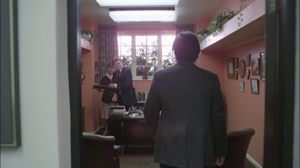No offense, but you're a little crazy. Maybe there's a gentler word. Geeky? Fanatical? Bored? One thing's for sure--your geeky, fanatical boredom is continued proof that spending too much time in the Overlook Hotel is bad for the brain. As a contributing (conspiracy) theorist on Room 237, you've gone to the obsessive lengths of mapping out the set for The Shining in an attempt to piece together Stanley Kubrick's puzzling horror picture. For some reason, you're trying to prove the impossibility of certain spatial relations within the film (I'll assume you've never seen a sitcom). But here's the even crazier thing: you're one of the more levelheaded contributors to this deep-down-the-rabbit-hole documentary.
Before I begin, a couple of caveats.
Even prior to getting my ornamental Bachelor's degree in Film Studies, Stanley Kubrick has been one of my favourite directors. I've always enjoyed finding deep social/political/cultural meaning in a film, and also believe that Kubrick is the worthiest of candidates for understanding the auteur theory in cinema. A movie like Room 237, dedicated entirely to both these things, sounded like a wet dream to me. Yet there I was - for large sections of the film, anyway - truly understanding how all work and no play makes this a dull film.
Director Rodney Ascher forgoes any talking heads in favour of the disembodied voices of_ Shining-enthusiasts, like you. This allows the audience to spend an enormous amount of time with _The Shinning, and other Kubrick films (which must account for over 95% of the footage in this documentary). The confinement to a Kubrickian diegesis (film studies!) has a hypnotic effect, allowing us to appreciate patterns and symmetry that may simply wash over the audience on casual viewings. But just as often, these narrations can be irksomely tedious when it feels like our guides are more lost in Kubrick's labyrinth than Jack Torrance.
Some readings are more convincing than others. Viewing the film as an analogy for the decimation of Native Americans or the Holocaust seems perfectly reasonable. The textual evidence may be trivial at best, but the overall conclusion is not irrational. Kubrick's mis-en-scene was certainly not happenstance, so picking up on visual clues (Calumet Indian head cans, traditional paintings, etc.) is a worthwhile exercise. But when attention to detail becomes a wildly subjective fishing expedition (like claiming a skiing poster "sort of looks like a Minotaur", ergo… whatever), the film starts to give film studies a bad name.
The documentary's biggest stretch, however, is also by far the most intriguing. The suggestion that Stanley Kubrick was recruited by the U.S. government to fake the original moon landing footage and subsequently coded that secret into The Shining is simply fan fiction fantasy. Sure, Danny wears an Apollo 11 sweater in the film, but everything beyond that is complete conjecture. Even the 9/11 "truther" doc Loose Change managed to make more convincing arguments.
Room 237 depends on half-baked theories that literally require watching the film forwards and backwards - at the same time - to overlay meanings. _The Shining _certainly earns the right to be closely examined and understood, but there's only about 45 minutes worth of proper content in this 90-minute documentary. The rest belongs locked away in chat rooms.
An axe sure would have been handy for cutting things down.
Studied out,
Christopher







